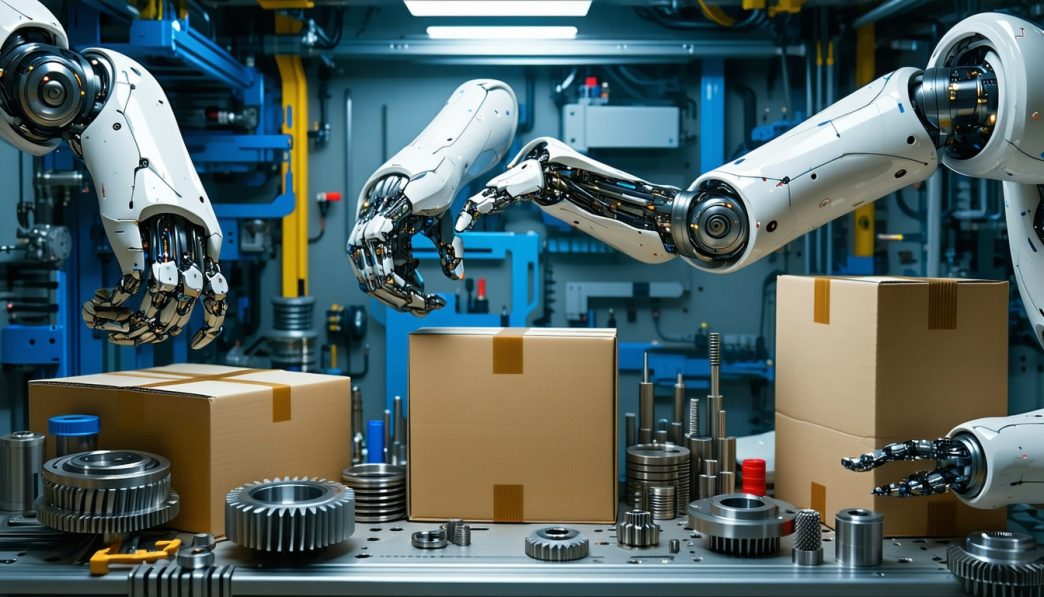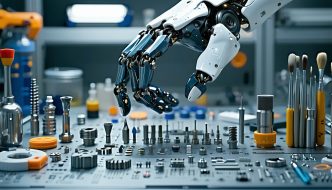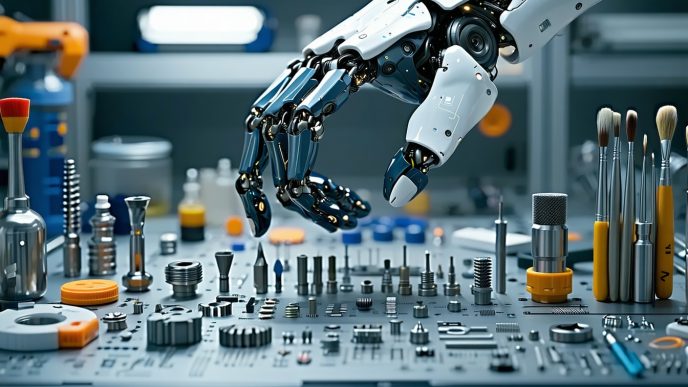Introduction to Robot Tool Usage
Importance of Tool Usage in Robotics
Tool usage is a critical element in the field of robotics. It significantly enhances a robot’s capability to perform a range of functions, from simple tasks to complex operations. As robots interact with the environment, their ability to use tools allows them to manipulate objects effectively and accomplish tasks that require precision. This is particularly important in fields such as manufacturing, healthcare, and service industries.
The tools that robots use can vary widely depending on the tasks they are designed to perform. For instance, a manufacturing robot may utilize cutting tools for assembly lines, while medical robots may employ specialized surgical instruments. Understanding the role of tools in robotic operations is essential for those interested in robot gripping and manipulation and the benefits these tools provide.
How Robots Extend Their Abilities with Tools
Robots extend their functional abilities through the use of tools in several ways. By equipping robots with different implements, they can:
-
Enhance Dexterity: Specialized tools enable robots to grip and manipulate objects with greater finesse. This capability is evident in dexterous robot hands, designed to mimic human-like movements.
-
Perform Specialized Tasks: Tools designed for specific applications allow robots to execute tasks that require specialized skills. Examples include robot grasping technology that helps in handling fragile items without causing damage.
-
Increase Efficiency and Productivity: Utilizing tools can significantly reduce the time and effort needed for various tasks. By automating repetitive actions, robots help streamline processes in settings like factories and warehouses.
-
Facilitate Complex Manipulations: Advanced tools paired with technologies such as tactile sensors in robot hands allow robots to perform intricate operations, such as assembling delicate parts or performing surgeries.
Here is a brief overview of how different tools can enhance robot capabilities:
| Tool Type | Purpose | Key Benefit |
|---|---|---|
| Grippers | Object manipulation | Increased grip strength |
| Cutting Tools | Material shaping | Precision in industrial tasks |
| Welding Tools | Joining materials | Efficiency in manufacturing |
By leveraging diverse tools, robots can improve their manipulation capabilities and tackle a variety of robot manipulation tasks. This versatility is a significant factor in the ongoing advancement of robotics and highlights the importance of tool usage in enhancing robotic performance and functionality.
Types of Tools for Robots
Robots utilize various tools to enhance their functionality and interact with the environment. These tools vary based on their intended applications and the complexity of tasks they need to perform. In this section, three key types of tools are discussed: grippers and end effectors, sensors for tool interaction, and cutting and welding tools.
Grippers and End Effectors
Grippers and end effectors serve as the primary means for robots to grasp and manipulate objects. They come in different designs, offering various levels of dexterity and gripping strength.
| Gripper Type | Description | Applications |
|---|---|---|
| Parallel Grippers | Open and close like human fingers | Pick and place tasks |
| Angular Grippers | Grasp objects at an angle | Handling irregular shapes |
| Suction Grippers | Use vacuum to hold objects | Assembly line operations |
| Soft Grippers | Made of flexible materials | Delicate object handling |
Grippers are vital for robot gripping and manipulation and can be designed to adapt to various shapes and sizes. Further exploration of these advanced designs can be found in our article on dexterous robot hands.
Sensors for Tool Interaction
To improve the precision of tool usage, robots incorporate sensors that provide feedback about their interactions with objects. These sensors allow robots to adjust their grip based on the properties of the objects they handle.
| Sensor Type | Functionality | Use Cases |
|---|---|---|
| Tactile Sensors | Detect pressure and texture | Handling delicate items |
| Force Sensors | Measure the amount of force applied | Ensuring safe object manipulation |
| Proximity Sensors | Detect the presence of nearby objects | Avoiding collisions |
| Vision Systems | Analyze visual information | Object recognition and sorting |
These sensors play a significant role in enhancing robot grasping technology, allowing robots to perform complex assembly tasks and manipulate objects accurately. For more on the different types of sensors, refer to our article about tactile sensors in robot hands.
Cutting and Welding Tools
In industrial applications, robots often require tools that can cut, weld, or modify materials. These tools are designed to perform tasks with high precision while ensuring safety and efficiency.
| Tool Type | Application | Characteristics |
|---|---|---|
| Cutting Tools | Slice through materials like metal and plastic | High precision, varying sizes |
| Welding Tools | Join materials together | High heat, customizable settings |
| Grinding Tools | Smooth and shape surfaces | Various abrasive materials |
Cutting and welding tools allow robots to tackle a range of robot manipulation tasks, from manufacturing to construction. Maintaining these tools with proper maintenance practices is essential for optimal performance.
By understanding the various types of tools utilized by robots, one can appreciate the diverse capabilities these machines possess in gripping, manipulating, and performing complex tasks across different industries. Exploring aspects like gripping strength in robots and adaptive gripping in robots further enhances the understanding of their functional ability.
Mechanisms for Tool Attachment
The mechanisms for attaching tools to robots play a crucial role in enhancing their functionality. Various attachment methods enable robots to interact with their environment effectively. This section will cover mechanical attachments, magnetic connections, and vacuum gripping systems.
Mechanical Attachments
Mechanical attachments are the most traditional method for securing tools to robots. These include various clamps, screws, and brackets that physically hold tools in place. Mechanical attachments are known for their strength and reliability, making them suitable for heavy-duty applications.
| Type of Mechanical Attachment | Description | Suitable Applications |
|---|---|---|
| Clamps | Holds tools securely using pressure. | Industrial manufacturing, assembly tasks. |
| Screws | Fixed attachment using threaded fasteners. | Robotics requiring permanent tooling solutions. |
| Brackets | Supports tools at specific angles or positions. | Automated machinery, robotic arms with specialized tools. |
Magnetic Connections
Magnetic connections utilize the forces of magnetism to attach tools to robots. This method allows for quick tool changes and easy detachment, which is particularly beneficial in environments where robots must switch tasks frequently. The strength of the magnetic connection depends on the materials used and the size of the magnets.
| Type of Magnetic Connection | Description | Advantages |
|---|---|---|
| Electromagnets | Magnetic force that can be turned on or off. | Flexible tool changes, ideal for dynamic tasks. |
| Permanent Magnets | Constant magnetic force for attachment. | Simple and reliable; requires no power supply. |
Magnetic connections are often used in scenarios that require a high degree of adaptability, such as automated production lines. For more information on how robots manipulate objects, visit our article on robot gripping and manipulation.
Vacuum Gripping Systems
Vacuum gripping systems operate using suction to hold tools or objects. These systems are highly effective for handling delicate or irregularly shaped items, as they distribute pressure evenly and minimize damage to surfaces.
| Component | Function | Applications |
|---|---|---|
| Vacuum Pump | Creates suction pressure. | Packaging, food handling, and delicate component assembly. |
| Suction Cups | Attach and release objects using vacuum. | Robotics in logistics and supply chain operations. |
| Control Valves | Regulate airflow to maintain or release suction. | Precision tasking in robotic applications. |
Vacuum technologies are especially useful in fields where robots are tasked with manipulating fragile items or performing precise movements. For insights into the technology behind robot grasping, check out our article on robot grasping technology.
Understanding these attachment mechanisms is critical for grasping how robots engage with tools in various applications, enhancing their utility and efficiency.
Adaptive Tooling for Precision Tasks
As robotics technology continues to advance, so does the ability of robots to perform precision tasks using adaptive tooling. These innovations enable robots to interact more effectively with their environment, enhancing their capabilities for a variety of applications.
Soft Robotics
Soft robotics is a field that focuses on creating robots made from flexible materials that can mimic the characteristics of living organisms. These robots are equipped with soft grippers that can adapt to the shape and size of the objects they interact with. This adaptability allows soft robots to handle delicate items without causing damage, making them suitable for tasks that require care, such as handling fruits or fragile components in manufacturing.
The advantages of soft robotics include:
| Feature | Benefit |
|---|---|
| Flexibility | Can conform to various shapes |
| Gentle handling | Reduces the risk of damage to fragile objects |
| Lightweight design | Easier to maneuver and deploy |
Soft robotics is an exciting area that broadens the range of applications for robot tool usage in sectors like agriculture and healthcare.
Advanced Gripping Systems
Advanced gripping systems are engineered to enhance a robot’s ability to grasp and manipulate objects with precision. These systems often incorporate multiple fingers, programmable degrees of freedom, and the capability to change grip based on the object’s texture and shape.
These gripping systems can include:
| Type of Gripper | Characteristics |
|---|---|
| Two-Finger Gripper | Simple design for lightweight objects |
| Multi-Finger Gripper | Increased dexterity mimicking human hands |
| Underactuated Gripper | Adapts to various shapes with fewer motors |
Robots utilizing advanced gripping systems can perform complex manipulation tasks more effectively, opening doors to precise applications in manufacturing and logistics sectors.
Tooling with AI Integration
Integrating artificial intelligence in robotic tooling enables smarter decision-making capabilities. Robots equipped with AI can learn from their interactions, adapt their grippers based on feedback, and optimize their tool usage for efficiency and effectiveness.
| AI Integration | Impact |
|---|---|
| Machine Learning | Enhances the robot’s ability to refine gripping techniques |
| Predictive Analytics | Anticipates object behavior for better handling |
| Adaptive Algorithms | Adjusts gripping techniques in real-time |
This level of intelligence not only improves gripping strength in robots but also enhances overall performance in dynamic environments. Robots leveraging AI tools can contribute to fields like logistics and assembly lines by reducing errors and increasing efficiency.
Adaptive tooling for precision tasks in robotics showcases the future of robot gripping and manipulation. Continued advancements in soft robotics, gripping systems, and AI integration will power the next generation of robots, further extending their capabilities to interact with the world around them.
Specialized Tools for Specific Applications
Robots are equipped with specialized tools that allow them to perform tasks tailored to specific sectors, showcasing their ability to adapt to various environments and requirements. This section explores the types of tools used by robots in the medical, industrial, and agricultural fields.
Surgical Tools for Medical Robots
Surgical robots utilize advanced tools designed for precision and accuracy in medical procedures. These tools often include robotic arms equipped with specialized instruments, such as scalpels, forceps, and suturing devices. The design of these tools enables surgeons to achieve finer control during operations, enhancing patient outcomes.
| Tool Type | Function | Key Features |
|---|---|---|
| Surgical Scalpels | Incision making | High precision, various sizes |
| Forceps | Grasping tissue | Different shapes for specific tasks |
| Suture Devices | Closing incisions | Automatic or manual control |
This evolution of robot gripping and manipulation has transformed surgical practices, allowing for minimally invasive techniques that reduce recovery time for patients.
Industrial Tools for Manufacturing Robots
Manufacturing robots are equipped with a variety of tools to enhance efficiency in production lines. These tools include welding torches, drills, and assembly fixtures. The ability to quickly switch between different tools allows these robots to perform multiple tasks, leading to increased productivity and consistency in manufacturing processes.
| Tool Type | Function | Key Features |
|---|---|---|
| Welding Torches | Joining materials | Versatile, precise heat application |
| Drills | Creating holes | Various sizes and depths available |
| Assembly Fixtures | Positioning components | Customizable setups for unique tasks |
With the advancements in robot grasping technology, industrial robots can perform complex assembly tasks that require a high level of dexterity.
Agricultural Tools for Farming Robots
Farming robots employ specialized tools tailored to agricultural tasks, such as planting, harvesting, and monitoring crops. Tools like seed dispensers, harvesters, and soil sensors are optimized for operation in challenging outdoor conditions. These tools enable robots to carry out repetitive tasks with high efficiency, enhancing crop yields and reducing labor costs.
| Tool Type | Function | Key Features |
|---|---|---|
| Seed Dispensers | Planting seeds | Adjustable rates for different crops |
| Harvesters | Gathering crops | Machine vision capabilities for accuracy |
| Soil Sensors | Analyzing soil conditions | Real-time data collection |
The integration of intelligent tools has improved the effectiveness of robot manipulation in farming, paving the way for the future of robotic agricultural practices, as discussed in our article on the future of robotic manipulation.
These specialized tools exemplify the versatility of robots and their ability to perform specific applications across various sectors efficiently. By continuing to develop and refine these tools, the field of robotics is set to expand its capabilities even further.
Challenges in Tool Usage for Robots
While robots have the potential to perform a variety of tasks using tools, they face several challenges that must be addressed to enhance their tool usage capabilities. This section will cover the difficulties associated with handling fragile objects, ensuring precision and accuracy, and managing tool maintenance and replacement.
Handling Fragile Objects
One of the main challenges in robot tool usage is the ability to handle delicate and fragile items without causing damage. Many applications require robots to interact with materials that have specific handling requirements, such as glass or thin plastics. For robots to manipulate these items effectively, they require advanced gripping technology that can provide a gentle yet firm hold.
| Object Type | Required Gripping Force (N) | Recommended Gripping Technology |
|---|---|---|
| Glass | 0.5 – 1.5 | Suction cups, soft robotics |
| Thin Plastics | 0.3 – 1.0 | Adaptive gripping, tactile sensors |
| Electronics | 0.5 – 2.0 | Precision grippers, dexterous robot hands |
Technologies such as adaptive gripping in robots and tactile sensors in robot hands aid in achieving the necessary delicacy during manipulation.
Ensuring Precision and Accuracy
Precision and accuracy are critical factors in successful tool usage by robots, particularly in applications such as manufacturing and surgery. Robots must achieve high accuracy in positioning tools to achieve the desired outcomes. Even minor errors in alignment can lead to significant problems in tasks such as assembly or cutting.
Numerous factors affect precision, including the design of the robotic arm, the calibration of the sensors, and the type of tools used. Ongoing research in robot grasping technology aims to improve accuracy by integrating advanced algorithms and hardware solutions.
| Application | Required Accuracy (mm) | Typical Robot Type |
|---|---|---|
| Surgical Procedures | 0.1 – 0.5 | Medical Robots |
| Assembly Line Work | 0.5 – 2.0 | Industrial Robots |
| Precision Farming | 1.0 – 3.0 | Agricultural Robots |
Improving gripping strength in robots also plays a role in achieving more precise and accurate tool usage.
Tool Maintenance and Replacement
Tool maintenance and replacement pose additional challenges in robotic applications. Robots require regular upkeep to ensure that their tools function correctly, which includes cleaning, sharpening, or replacing worn-out components. Neglecting maintenance can lead to tool failure, degraded performance, or accidents.
Furthermore, in a fast-paced environment, downtime for tool maintenance can be detrimental to productivity. Robotics engineers are working on solutions to automate the maintenance process, minimizing the time robots spend offline. This includes the development of robot manipulation tasks that include self-checking capabilities to evaluate and report tool condition.
| Maintenance Task | Frequency | Impact of Neglect |
|---|---|---|
| Cleaning Tools | Daily | Increased wear, inefficiency |
| Tool Sharpening | Weekly | Diminished performance |
| Replacement of Components | As needed | Risk of malfunction |
Addressing these challenges is essential for advancing robot tool usage and enhancing the performance of robots across various industries. For further insights into the future of robotic manipulation, refer to our article on future of robotic manipulation.
Future Trends in Robot Tool Development
As the field of robotics continues to evolve, several trends are shaping the future of robot tool usage. The integration of advanced technologies is enhancing how robots interact with their environments, enabling more sophisticated manipulation and gripping capabilities.
Integration of Machine Learning in Tool Usage
Machine learning is revolutionizing how robots learn to utilize tools effectively. By analyzing data from previous tasks, robots can develop improved strategies for tool usage, allowing for greater adaptability in real-world situations. This technology enables robots to recognize patterns in their interactions with tools, thus enhancing their performance in applications ranging from manufacturing to healthcare.
A comparison of traditional programming versus machine learning-based approaches highlights the efficiency gains:
| Approach | Speed of Adaptation | Learning Curve | Task Performance |
|---|---|---|---|
| Traditional Programming | Slow | Steep | Consistent |
| Machine Learning | Fast | Gradual | Increasing over time |
Robots using machine learning can perform complex tasks with greater precision, increasing the effectiveness of their gripping and manipulation abilities. For a deeper insight into these advancements, refer to our article on robot manipulation tasks.
Collaboration Between Robots and Humans for Tooling
The future of robotics also emphasizes collaboration between robots and humans. This partnership enhances tool usage as robots can learn from human inputs while providing assistance in various tasks. Human operators can guide robots, allowing for nuanced interactions with tools, which is particularly beneficial in fields like healthcare and manufacturing.
Key benefits of human-robot collaboration include:
| Benefit | Description |
|---|---|
| Improved Efficiency | Robots can handle repetitive tasks, freeing humans for more complex activities |
| Enhanced Precision | Humans provide oversight, improving accuracy in critical applications |
| Increased Safety | Robots can take on dangerous tasks, reducing risk to human workers |
This synergy leads to more effective manipulation techniques, improving overall task outcomes. For more information on human-robot interactions, see our article on adaptive gripping in robots.
Nanotechnology for Miniaturized Tools
Nanotechnology is opening new possibilities for the development of miniaturized tools that robots can use for intricate tasks. Smaller, more precise tools enable robots to perform detailed operations that were previously unachievable. Applications in areas such as surgery and delicate assembly highlight the potential of nanotechnology in enhancing robot tool usage.
Comparison of conventional tools versus nanotechnology-enhanced tools:
| Tool Type | Size | Precision Level | Application Areas |
|---|---|---|---|
| Conventional Tools | Standard sizes | Moderate | General tasks |
| Nanotechnology Tools | Microscopic | High | Surgical, electronic assembly |
These advancements facilitate exceptional dexterity and control, making robots increasingly capable of undertaking sophisticated jobs. For insights into how robots achieve dexterity, check out our article on dexterous robot hands.
The future of robot tool development is poised for significant advancements as machine learning, collaboration with humans, and nanotechnology converge to redefine how robots grip and manipulate their environment.















